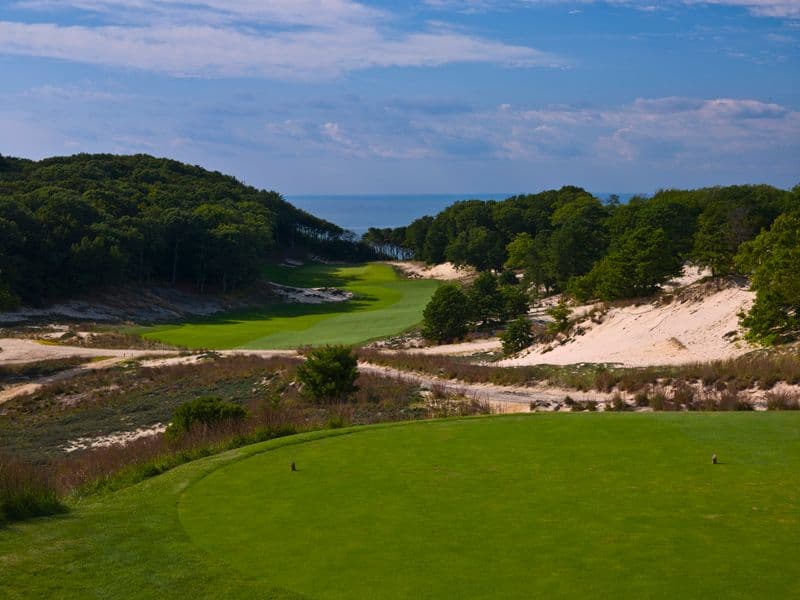- Courses
- North America
- USA
- New York

- Address3000 Sound Ave, Riverhead, NY 11901, USA
Friar’s Head is located at Riverhead, New York a short distance from Shinnecock Hills. Set in 350 acres, this rugged course was designed by Bill Coore and Ben Crenshaw and opened for play in 2003 with the philosophy that golf at Friar’s Head should be about options and creativity.
It is a private club where caddies must be used at all times. There are no yardage markers on the course and both members and guests are encouraged to walk the course as opposed to using buggies.
Friar’s Head is routed through rugged, wooded dunes and former farmland. The course starts in the dunes, holes 2 -7 and 11-13 are sited on an old potato farm then the remaining holes are back in the sand hills.
Some of the greens are enormous – they vary in size from 3,000 to 18,000 square feet. Many bunkers are both bearded and huge; others are long strips that are merely huge! To the north of the property, there are 200-foot cliffs overlooking Long Island Sound.
The signature, par four 15th hole is 460 yards long. From an elevated tee position, the tee shot must avoid a cavernous bunker which gathers in shots as the fairway slopes from right to left. The approach shot is then played to a green framed to the rear by trees which partially shield it from winds coming off the Sound.
The following article was written by the Golfclubatlas.com website co-founder John Morrissett and is an edited extract from Volume Three of Golf Architecture: A Worldwide Perspective . Reproduced with kind permission. To obtain a copy of the book, email Paul Daley at fswing@bigpond.net.au
“What a great place for a golf course!” That innocent remark, made by a golfer on completion of his round at Friar’s Head, captures the tremendous thought and work that went into the course, as the finished course looks like an effortless creation preordained for that piece of land. In truth, however, the course presented a real challenge to its architects, Bill Coore and Ben Crenshaw, and the course’s evolution lends insight into their genius.
The property for the Friar’s Head course offered 350 acres on the north shore of Long Island in Baiting Hollow, a hamlet of Riverhead. It included bluffs of three quarters of a mile that rose steeply 150 to 200 feet above the Long Island Sound. There were 165 acres of tree-covered dunes – actually, hills formed by glacial deposits – sandwiched between the crest of the bluffs to the north and farmland to the south.
Although the wooded dunes – housing significant and wild topography with 50 to 75-foot steep elevation changes – stretched unevenly to the south, they uniformly ended abruptly when giving way to the farmland. The unbroken tree line dividing these two starkly contrasting environments served as an immediate warning that this would not be an easy site on which to build a golf course.
Yes, memorable holes could be built among the dunes. However, the dense woods and underbrush made it impossible to discern quickly just how many holes could be properly routed in that section of the property without markedly altering the landscape, which Coore and Crenshaw were philosophically opposed to doing.
The architects strongly believed that this diverse site deserved more than just another Jekyll and Hyde course, so much so that they delayed committing to Friar’s Head for well over a year until they were confident after numerous site visits that they had solved the puzzle and found a routing that would result in something better.
Coore was determined for the holes to flow together as a single course, with seamless transitions between the dunesland and farmland parts of the property. The result of this daunting task is a testament to his painstakingly thoughtful routing of the holes and his firm’s strengths with respect to the details and finishing work.
Eight of the holes are located entirely in the dunes, while four additional holes either start or finish in that section of the property. Each nine starts in the dunes, spills down into the farmland, and then returns to the dunes. The 2nd, 7th, 11th and 14th holes (all three-shotters) ease the transition between the dramatically different parts of the property during play of a hole.
Soon after completing Friar’s Head, Bill Coore was asked what was the best property, other than Sand Hills, on which he and his partner had worked. His studied reply was that, in hindsight, Friar’s Head had proven to be so. Having the natural qualities of a property shine through after tireless work to build the best course possible reflects the highest compliment that can be paid to a design.
Course Reviews
Leave a Review
This course has not been reviewed.
If you have played this course, consider .
Thanks for the review
Your review has been successfully submitted and will be reviewed for approval.
Course Reviewed
You’ve already submitted a review for this course.
Course Architect
View All
Coore and Crenshaw Inc. was established in 1986, but five years passed before the partnership made a real architectural impact when the Plantation course at Kapalua burst onto the scene in 1991.



